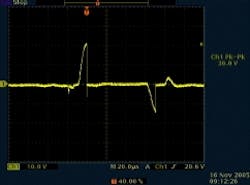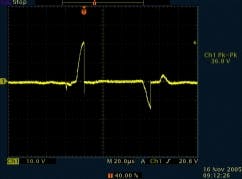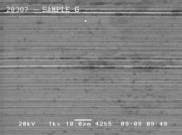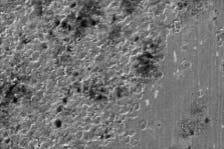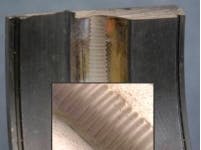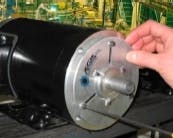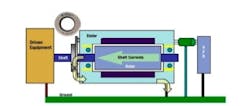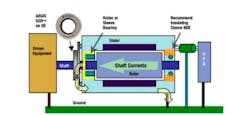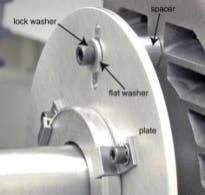Shaft grounding -- Fulfilling the promise of variable frequency drives
By Adam Willwerth
With the rising cost of energy, the use of variable frequency drives (VFDs) is growing at an increasing rate. By optimizing the frequency of a three-phase alternating-current (AC) induction motor's voltage supply, a VFD controls the motor's speed and torque while providing energy savings. And, these energy savings can be quite substantial -- -- 20% or more -- -- making VFDs a "green" solution as well as a wise money-saving investment.
However, in order to be truly "green," a technology must be sustainable as well as energy efficient. Yet the currents induced on motor shafts by VFDs can wreak havoc with motor bearings, dramatically shortening motor life and severely diminishing the reliability of systems. To mitigate these currents and realize the full potential of VFDs, a cost-effective method of shaft grounding is essential.
Already common in heating, ventilation, air conditioning, pumping, and industrial automation systems, VFDs are catching on in many other applications as they become smaller and more powerful, more reliable, easier to program, and less expensive. But to prevent energy savings from being wiped out in a single system failure, VFD/motor systems must be designed for reliability and trouble-free operation.
While VFDs are not without certain drawbacks, these can now be easily overcome. Whether used to save energy or increase the accuracy of process control, VFDs only achieve their full potential when carefully matched to the application and installed with appropriate safeguards such as motor-shaft grounding rings that protect bearings from VFD-induced damaging shaft currents. Such safeguards will eliminate the need for expensive repairs, and enable VFDs to fulfill their promise of energy and cost savings.
Tremendous Energy-Saving Potential
In today's typical VFD, a rectifier (thyristor or diode) converts the AC utility feed to direct current (DC). A filter (inductors and capacitors) smoothes the current's waveform. A pulse-width modulation (PWM) inverter then turns it back to AC in variable form using insulated gate bipolar transistors (IGBTs). Typical output frequency, also called the carrier or switch frequency, is 2 to 12 kHz, or 2,000 to 12,000 on/off cycles per second. VFDs may be used to directly drive one or more motors in constant-torque applications, to ensure that they do not use any more power than necessary. With encoder feedback, a VFD can also be used to control the speed of a motor by modulating the voltage and frequency of power to the motor according to programd parameters.
In the field of flow control, the potential for increased efficiency with VFDs is especially dramatic. Many centrifugal fans and pumps run continuously but often at reduced loads. Because the energy consumption of such devices correlates to their flow rate cubed, the motors that drive them will use less power if controlled by a VFD. In fact, if a fan's speed is reduced by half, the horsepower needed to run it drops by a factor of eight. With rising energy costs, restricting the work of a motor running at full speed through the use of dampers and other throttling mechanisms seems needlessly wasteful.
In constant-torque applications where the main objective is more accurate process control, such as reciprocating compressors, conveyors, mixers, machine tools, etc., a VFD can be programd to prevent the motor from exceeding a specific torque limit. This protects the motor, and in some cases associated machinery and products, from stress and damage. If a machine jams, for instance, the motor that powers it will, without the moderating influence of a VFD, draw excessive current until its overload device shuts it down.
Regardless of the application, the VFD must be compatible not only with the motor but also with every other system component. To avoid pitfalls, it should be selected by someone who understands the entire system, including all of its possible current paths. Systems engineers should have the expertise to review all pertinent engineering specifications, operating conditions, and performance curves. Operator training is equally important. With informed decisions from specification all the way through to operation, potential problems can be identified and resolved.
Potential Problems
Because the waveform from a VFD is generated by pulse-width-modulated switching, it has high-frequency components which are capacitively induced onto the motor shaft and discharge through the bearings. These are not pure sine waves; they contain high-frequency currents and voltages called harmonic content, the potential effects of which are many. And even when the motor is designed for inverters it is vulnerable to bearing failure from VFD-induced currents.
Hard to predict but easier to prevent, motor shaft currents induced by VFDs can damage motor bearings. Although best addressed in the design stage of a system, these currents can usually be mitigated by retrofitting previously installed motors. Without some form of mitigation, shaft currents (also known as eddy currents) discharge to ground through bearings, causing pitting, fusion craters, and "fluting." This unwanted electrical discharge machining (EDM) leads to excessive bearing noise, premature bearing failure, and subsequent motor failure.
Motors are never fully compatible with the VFDs that drive them unless these shaft currents are addressed and mitigated. Obviously, the significant cost savings that VFDs deliver in so many applications can all be wiped out if a motor fails because its bearings are vulnerable.
And there is considerable evidence to prove that VFD-induced bearing damage is a large and growing problem. Consider:
• Most motor bearings are designed to last for 100,000 hours, yet motors controlled by VFDs can fail within one month (720 hours).
• An HVAC contractor recently reported that, of the VFD-controlled 30-60 HP vane axial fan motors he installed in a large building project, all failed within a year (two within 6 months). Repair costs totaled more than $110,000.
• Several large pulp and paper companies surveyed noted that the VFD-controlled AC motors used in their plants typically fail due to bearing damage within six months.
• The largest motor manufacturer in the United States has cited eliminating drive-related motor failures as its number-one engineering challenge.
• Almost a dozen Internet blogs focus on problems presented by VFD-induced shaft currents.
• Motor failures caused by VFD-induced shaft currents result in hundreds of thousands of hours of unplanned downtime every year in the United States alone. In addition, these failures affect the performance and mean time between failure (MTBF) of whatever original equipment systems the motors support.
• With recent motor-price increases due to rising copper prices, this problem will become even more costly.
One company, Electro Static Technology, has developed an innovative solution to the problem -- the AEGIS SGR Bearing Protection Ring™. Engineered with special conductive microfibers, the ring redirects shaft currents and provides a reliable, very-low-impedance path from shaft to frame, bypassing the motor bearings entirely.
Various other negative effects can also manifest themselves if the driven motor is not designed for use with a VFD or if either the motor or the VFD is not rated properly for the application or the load. For example, when required to maintain a constant torque, a motor tends to lose some efficiency, running hotter at lower speeds but hotter still when controlled by a VFD. If such a motor must be operated at less than 30% of its maximum speed, it may need extra cooling or thermal protection. Similarly, a VFD-controlled motor's capability to produce torque drops more quickly at lower motor speeds than would that of a motor using pure sine wave power. For constant-torque loads, a VFD should be rated for 60 seconds at 150% of the load. A VFD's current rating also limits the load-acceleration rate.
Another rule of thumb is that the cable connecting a VFD with a motor should not be more than 50 feet long, or else two different wave types could meet at the motor terminals and in effect double the voltage received by the motor. If a longer cable is required, extra line filtering is recommended to protect the motor and other sensitive equipment nearby from harmonic content and radio frequency interference (RFI). RFI can also be reduced by enclosing motor leads in a rigid conduit. Regardless of its length, the cable between a VFD and the motor or motors it regulates can be enclosed in a corrugated aluminum sheath or another kind of grounded low-impedance shielding.
VFDs may also not be appropriate for systems that must maintain high pressure. During periods of low flow, a VFD-controlled pump motor may not be able to slow down enough without reducing pressure.
For systems that require dynamic braking, VFDs are available with an optional power load resistor that can shunt excess energy from the DC bus.
A Closer Look at Bearing Damage
Every VFD-controlled AC motor develops a parasitic capacitance between the stator and rotor. Short of dismantling the motor, there are two main ways to check for bearing damage from induced shaft currents -- measuring vibration and measuring voltage. Both require special equipment and experienced personnel to conduct tests and analyze the results. Both are best used to establish a baseline early on, so that trends can be monitored later. Neither method is foolproof.
By the time vibration tests confirm bearing damage by identifying particular energy spikes in the range of 2 to 4 kHz, the damage has usually reached the "fluting" stage. Likewise, the main benefit of voltage tests may be the relief they provide when the results indicate no bearing damage. If a baseline voltage measurement is taken right after a VFD has been installed, successive tests may provide early warning of harmful current loops, but there are many variables -- predicting bearing damage is not an exact science.
These voltages repeatedly build up on the rotor to a certain threshold, then discharge in short bursts along the path of least resistance, which all too often runs through the motor's bearings to the frame (ground). Serious bearing damage is thought to be more likely in systems that operate with high carrier frequencies, a constant speed, or inadequate grounding.
A high carrier frequency of course means a high discharge rate. For this reason it is advisable to purchase a VFD that permits fine tuning of the carrier frequency in increments no larger than 1 kHz. In general, it is advisable to keep the frequency as low as possible, and no higher than 6 kHz.
There is some debate as to whether constant-speed operation makes VFD-controlled motors more vulnerable to electrical bearing damage. Obviously, the question is moot since VFDs are seldom used in applications that require constant speed.
Mitigating Bearing Damage
As explained above, electrical damage to AC motor bearings often begins at startup and grows progressively worse. As a result of this damage, the bearings eventually fail. To guard against such damage and thus extend motor life, the induced current must be diverted from the bearings by means of mitigation technologies such as insulation, shielding, and/or an alternate path to ground. These technologies vary in terms of their cost and effectiveness.
Insulating motor bearings is a partial solution that more often than not shifts the problem elsewhere. Blocked by insulation, shaft current seeks another path to ground. Attached equipment, such as a pump, often provides this path, and it frequently winds up with bearing damage of its own. In addition to being expensive, insulation is subject to contamination. Worse yet, some types of insulation can be totally self-defeating: In certain circumstances, the insulating layer has a capacitive effect on high-frequency VFD-induced currents, allowing them to pass right through to the bearings it was supposed to protect.
A Faraday shield can be created by installing grounded conductive material such as copper foil or paint between the stator and rotor. If built to the proper specifications for the motor, this can block most of the harmful currents that jump across the motor's air gap. However, this mitigating measure is often expensive and difficult to implement, and attached equipment could still be vulnerable to deflected currents.
Likewise, nonconductive ceramic ball bearings divert currents from the main motor's bearings but leave attached equipment open to damage of its own. Ceramic bearings can be costly and usually must be resized to handle mechanical static and dynamic loadings.
Yet another mitigation attempt comes in the form of conductive grease, which, in theory, bleeds off harmful currents by providing a lower-impedance path through the bearings. In practice, however, the conductive particles in the grease increase mechanical wear.
Metal grounding brushes certainly help. They contact the motor shaft to provide alternate paths to ground. Unfortunately, they also wear out and corrode, thus requiring regular maintenance.
As explained above, alternate discharge paths to ground, when properly implemented, are preferable to insulation because they neutralize shaft current. Techniques range in cost and sometimes can only be applied selectively, depending on motor size or application. The ideal solution would provide an effective, low-cost, very-low-resistance path from shaft to frame and could be broadly applied across all VFD/AC motor applications, affording the greatest degree of bearing protection and maximum return on investment. The AEGIS SGR meets all these criteria. Its patent-pending Electron Transport Technology™ uses the principles of ionization to boost the electron-transfer rate and promote extremely efficient discharge of the high-frequency shaft currents induced by VFDs.
The versatile AEGIS SGR is scalable to any NEMA or IEC motor regardless of shaft size, horsepower, or application. SGRs have been successfully applied to power generators, gas turbines, AC traction and break motors, cleanrooms, HVAC systems, and a long list of other industrial and commercial applications.
For VFD-equipped motors of less than 100 HP (75 kW) with shaft diameters of less than 2" (50mm), a single SGR on the drive end of the motor shaft is typically sufficient to divert harmful shaft currents.
Large AC motors (100HP/75kW or more) and even large DC motors, especially those with shaft diameters of more than 2" (50mm), are more likely to have high-frequency circulating currents (as well as EDM-type discharges) that can damage bearings. Motors with roller bearings are also more vulnerable to damaging circulating currents because roller bearings have a greater surface area and their lubricant layer is usually thinner. Such motors benefit from the combination of an SGR on the drive end and insulation on the non-drive end to break the circulating current path. This may also be the solution in situations where installing an SGR on the non-drive end would be impractical because of encoders, fans, or other special circumstances.
This is also a common solution for motors above 500HP (375kW), and most manufacturers already take this approach. However, when insulation on the drive end is not designed into the motor or cannot be easily installed, two SGRs are recommended -- one on the drive end (DE) and one on the non-drive end (NDE).
In critical applications where motors with two ceramic bearings are specified, at least one SGR should be used to ensure that shaft voltage does not pass down the line to attached equipment such as gear boxes, pumps, encoders, pillow block bearings, or break motors.
Maintenance-Free and Guaranteed
Once installed, the SGR requires no maintenance. Unlike conventional shaft grounding brushes, its conductive microfibers work with virtually no friction or wear; are unaffected by dirt, grease, or other contaminants; and last for the life of the motor regardless of RPM. Test results show surface wear of less than 0.001" per 10,000 hours of continuous operation and no fiber breakage after 25 million direction reversals.
Warranty claims against motor and VFD manufacturers for electrically damaged bearings may not pan out. Many factors promote bearing damage, which often occurs even when the VFD and motor are perfectly matched to the application and to each other and neither is defective. However, Electro Static Technology guarantees that any new motor (up to 100HP/75kw) on which the SGR is properly installed will not fail from electrical fluting damage to bearings.
AEGIS SGR: A Viable, Cost-Effective Solution to Shaft Current Problems
Motor manufacturers and process engineers in industries where VFDs are used are keenly aware of the problems and expense caused by electrical damage to bearings. They have expended significant time, effort, and money to find a solution to this problem. The AEGIS SGR Conductive MicroFiber Bearing Protection Ring™ is the most effective and universally applicable solution to date.
The AEGIS SGR also provides true value for the customer. Typically, an AC motor coupled with a VFD costs from $2,400 to $100,000 or more and may be part of a manufacturing process that generates revenues from $10,000 to $1,000,000 or more per hour. The cost of installing an SGR is very low when compared to the cost of the overall system, usually less than 1% of the equipment cost.
By preventing electrical damage to bearings, the SGR protects the VFD system from the costly downtime of unplanned maintenance. In some production applications, even a momentary stoppage due to motor failure can cost more than $250,000, excluding the cost of repairing the motor. In all but the smallest applications, the SGR provides a sustainable path to energy savings and an exceptionally high return on investment.
About the Author: Adam Willwerth is Development Manager for Electro Static Technology, 31 Winterbrook Road, Mechanic Falls, ME 04256-5724, TEL: (207) 998-5140, FAX: (207) 998-5143, www.est-aegis.com.
WaterWorld Online, August 2009
###
